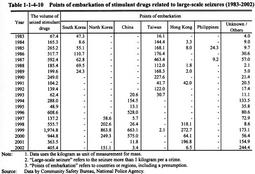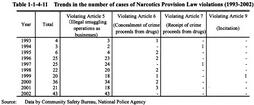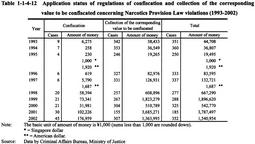| Previous Next Index Image Index Year Selection | |
|
|
2 Crackdown status of drug offenses (1) Seizure of stimulant drugs Table 1-1-4-9 shows the amount of stimulant drugs and other drugs seized over the last 20 years. The amount of these illegal drugs seized, though being the tip of the iceberg and not coinciding with the actual status, is considered to show trends in the demand for drugs.
The amount of seized stimulant drugs (powders) stayed somewhere between 80-800 grams until 1998, but rose sharply in 1999, reaching about 1,994 kilograms and about 1,031 kilograms in 2000. It then declined sharply in 2001 and fell to about 442 kilograms in 2002. The amount of seized cannabis over the last 20 years peaked at about 995 kilograms in 2001, but declined to about 621 kilograms in 2002. Recently, the amount of seized synthetic narcotic tablets such as MDMA has increased, reaching a record of 190,281 tablets in 2002, up from 112,568 in the previous year. Table 1-1-4-9 The amount of seized stimulant drugs and narcotics, etc. (1983-2002) (2) Point of embarkation of stimulant drugs Table 1-1-4-10 shows the points of embarkation of stimulant drugs found in large-scale seizures over the last 20 years. South Korea and Taiwan were major points of embarkation of stimulant drugs around 1984, the second peak of the abuse of stimulant drugs. Then, China and North Korea became as the major points of embarkation from 1993 and 1997 respectively, and currently, these two countries and Hong Kong are the major points of embarkation.
Table 1-1-4-10 Points of embarkation of stimulant drugs related to large-scale seizures (1983-2002) (3) Implementation status of the Narcotics Provision Law The Narcotics Provision Law was enacted on October 5, 1991, and entered into force in July 1992. The Law established the regulations concerning punishment for illegal smuggling etc. operated as businesses, punishment for money laundering , and confiscation and collection of the corresponding value to be confiscated necessary for drug crime proceeds, and the realization of controlled delivery on an international level.
Table 1-1-4-11 shows the number of Narcotics Provision Law violations since 1993. The number was under 10 from 1993 to 1995, jumped to 25 in 1996, stayed within the 20-40 range for some years, and reached a record of 43 in 2002. Table 1-1-4-11 Trends in the number of cases of Narcotics Provision Law violations (1993-2002) Table 1-1-4-12 shows the application status of regulations of confiscation and of collection of the corresponding value to be confiscated, which are one of the characteristics of Narcotics Provision Law violations. The total amount of confiscation and collection exceeded ¥100 million in 1997, reached around ¥667 million in 1998, around ¥1,896 million in 1999, and around ¥542 million in 2000. It then reached a record of ¥3,787 million in 2001, but declined to about ¥1,540 million in 2002.Table 1-1-4-12 Application status of regulations of confiscation and collection of the corresponding value to be confiscated concerning Narcotics Provision Law violations (1993-2002) |



